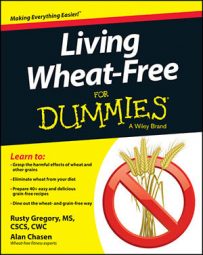You've probably heard a lot about wheat and gluten and their detrimental effects on the human body; these two can pack a powerful punch. Understanding who these two culprits are and where to find them is a vital step in eliminating them from your diet.
Learn how wheat and gluten are different and why those differences are important. You might also dig into the purposes of gluten in foods and products. You’ll want to be aware of some of the conditions and diseases associated with wheat and gluten consumption and how to treat them.
Finally, learn how a wheat- or grain-free diet differs from a gluten-free diet and the foods that need to be avoided and can be included in both.
Because they're closely related, the words wheat and gluten are often used interchangeably to describe sensitivities or allergies to certain foods. But this usage is incorrect and causes a lot of confusion. Wheat is a cereal grain and made up of carbohydrates. Gluten is a large protein, made up of smaller proteins, that gives food its elasticity.
Here, read what gluten is and why it's found in so many foods. Then learn why you need to understand what the terms wheat-free, grain-free, and gluten-free mean in terms of your diet.
Of the three, grain-free is the most restrictive.
Defining gluten and its uses
Gluten is a grouping of proteins found in wheat, barley, and rye. Some people are known to be sensitive to certain types of gliadin, one of the proteins that make up gluten. In food preparation, gliadin's main purpose is to add consistency, chewiness, flavor, and protein.
Gluten is also used in various household products, such as medications and skin lotions. The gluten in these products acts as a filler or binding agent.
But with all its positive contributions, gliadin can have serious consequences. In some people, gliadin can cause inflammation and the inability to absorb nutrients in the small intestine.
These effects lead to autoimmune diseases such as celiac disease, osteoporosis, and arthritis. Other people experience less-intense reactions to gluten that still tend to affect their digestive systems.
The differences between wheat and gluten affect your situation
You've probably seen the words wheat-free and gluten-free used interchangeably on food labels. But they're not interchangeable. Knowing the difference is essential when you start eliminating either one from your diet, for the following reasons:
You may have a specific condition that dictates what you cut from your diet. You need to know why you're eliminating wheat, grains, gluten, or all of the above. Have you been diagnosed with celiac disease, are you allergic to wheat or grains, or are you gluten intolerant?
To see results, you have to cut the right things. A working knowledge of what you can eat is critical if you're going to be successful with your new lifestyle. This is especially important knowing that a reaction can occur with wheat/grains and not gluten, and vice-versa. The slightest amount of wheat, grains, or gluten left in a diet where it has been eliminated can be enough to prevent you from seeing the progress that you're hoping for.
You can save your sanity by knowing where the line is. Making only necessary sacrifices can help you avoid becoming overwhelmed by this major life change. If you're giving up wheat or gluten but not all grains, understanding which items you can keep makes a diet change a little less daunting. That may sound silly now, but when you're cutting foods out of your diet, every little win counts. (If you're giving up gluten or grains, sorry; you have to give up all the wheat, too.)

